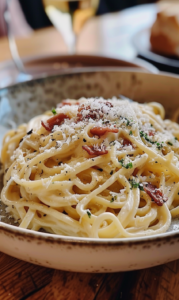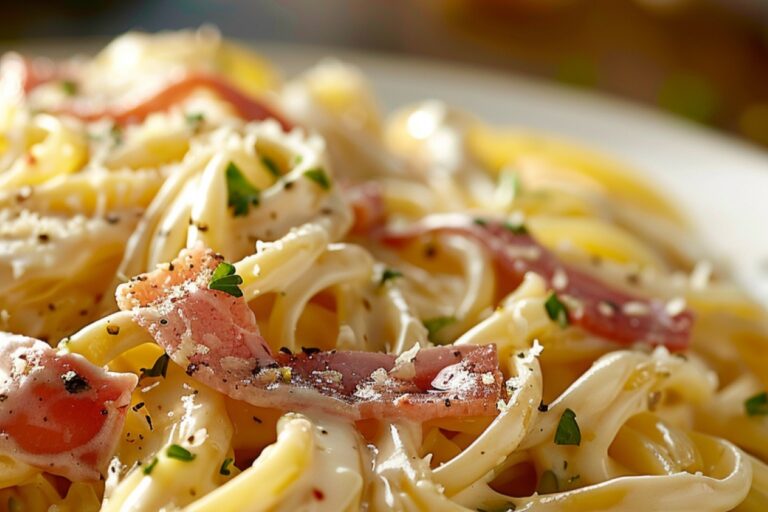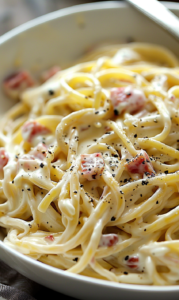Exploring the Tasty Differences: Carbonara vs Alfredo
In the realm of Italian cuisine, few dishes stir as much passion and debate as Carbonara and Alfredo. Both are beloved for their creamy textures and comforting flavors, but they hold distinct identities that set them apart. This article dives deep into what makes each dish unique, from their origins to the specific ingredients that define them. Whether you’re a home cook or a culinary aficionado, understanding the nuances between these two classic pastas can elevate your cooking and appreciation for Italian gastronomy.
Carbonara Recipe: A Dive into Authentic Italian Flavor
Summary and Origin
Carbonara is a quintessential Italian dish, rumored to have been a favorite among charcoal workers in the Apennine hills of Italy—hence the name, stemming from carbonaro which means charcoal burner. This dish is a celebration of simplicity and flavor, traditionally made with just a few key ingredients: eggs, Pecorino Romano cheese, guanciale, and black pepper. The absence of cream in authentic carbonara recipes is a testament to the dish’s reliance on the magical emulsion of egg yolks and pasta water, which together create a silky, creamy sauce without a drop of cream.
Recipe Details
- Servings: Serves 4
- Advanced Servings: Easily scalable for larger gatherings
- Prep Time: 10 minutes
- Cook Time: 20 minutes
- Custom Time Label: Resting Time
- Custom Time: 5 minutes resting
- Total Time: 35 minutes
- Categories: Main Course, Italian Cuisine, Pasta Dishes
-
Equipment:
- Amount: 1
- Name: Large skillet
- Notes: Preferably non-stick for better handling of eggs
- Amount: 1
- Name: Large pot
- Notes: For boiling pasta
-
Ingredients:
- Amount: 100g
- Unit: grams
- Name: Guanciale
- Notes: Pancetta can be used as a substitute, though guanciale is traditional for its unique flavor.
- Additional ingredients like Pecorino Romano, fresh eggs, spaghetti, and a generous pinch of freshly ground black pepper.
-
Instructions:
- Begin by boiling pasta in salted water until al dente. Simultaneously, render the guanciale in a pan until crispy.
- Whisk together egg yolks and cheese, gradually adding hot pasta water to form an emulsion.
- Quickly toss the pasta with the egg mixture and cooked guanciale, allowing the residual heat to cook the eggs slightly and coat the pasta in a creamy sauce.
- Serve immediately, garnished with additional cheese and pepper.
- Nutrition: Approximately 500 calories per serving.
- Notes: The key to perfect carbonara lies in the timing; the pasta must be hot enough to cook the egg just right, creating a creamy, not scrambled, texture.

Discover the joys of this traditional Italian dish and bring a piece of Italy into your kitchen. By following these guidelines, you’re well on your way to mastering a classic Carbonara that’s sure to impress. For further insights into pasta types and their pairings, explore Pasta Types and Pairings, enhancing your culinary repertoire with expert knowledge.
Alfredo Recipe: Creamy Delight in Every Bite
Summary and Origin
The Alfredo sauce, often associated with decadent creamy pasta, was born in 1914 in Rome, Italy, at the hands of Alfredo Di Lelio. Originally crafted to entice his pregnant wife’s appetite, the dish was a simple concoction of butter and Parmesan, which together created a rich, velvety sauce. The introduction of heavy cream into the recipe outside of Italy helped transform it into the globally beloved version known today.
Recipe Details
- Servings: Serves 4
- Advanced Servings: Adjust ingredients proportionally for smaller or larger groups
- Prep Time: 15 minutes
- Cook Time: 15 minutes
- Custom Time Label: Additional Ingredients Prep
- Custom Time: 10 minutes
- Total Time: 40 minutes
- Categories: Main Course, Italian Cuisine, Creamy Pasta Dishes
- Equipment:
- Amount: 1
- Name: Large saucepan
- Notes: Used for sautéing and combining ingredients.
- Amount: 1
- Name: Whisk
- Notes: Essential for achieving a smooth sauce.
- Ingredients:
- Amount: 2 cups
- Unit: cups
- Name: Heavy cream
- Notes: The base of the sauce; light cream can be substituted for a less rich version.
- Additional ingredients listed below in the table format.
- Instructions:
- Start by melting butter over medium heat and sautéing minced garlic until fragrant.
- Slowly add the heavy cream and bring to a low simmer, careful not to boil.
- Gradually mix in grated Parmesan until the sauce thickens.
- Toss with cooked fettuccine and serve topped with parsley and extra Parmesan.
- Nutrition: Approximately 700 calories per serving.
- Notes: Alfredo is versatile. Feel free to add proteins like grilled chicken or shrimp for a complete meal.
Ingredients Table
| Amount | Unit | Ingredient | Notes |
|---|---|---|---|
| 2 | cups | Heavy cream | Light cream for a lighter sauce alternative |
| 1/2 | cup | Butter | Unsalted preferred |
| 1 | cup | Parmesan cheese | Freshly grated for best flavor |
| 4 | cloves | Garlic | Minced, adjust according to taste |
| 1 | bunch | Parsley | Fresh, chopped for garnishing |
| 1 | lb | Fettuccine | Cook until al dente, follow package instructions |
Cooking Process Table
| Step | Action | Time | Notes |
|---|---|---|---|
| 1 | Sauté garlic in butter | 2 min | Keep heat medium to avoid burning garlic |
| 2 | Add cream and simmer | 8 min | Stir occasionally to prevent sticking |
| 3 | Mix in Parmesan until thickened | 5 min | Remove from heat once desired consistency is reached |
| 4 | Toss with pasta and garnish | 2 min | Serve hot with additional cheese and parsley |
This section of the article not only shares the steps to create a traditional Alfredo sauce but also embeds useful tables that outline the ingredients and cooking process, providing an at-a-glance guide to crafting this creamy, classic dish.

